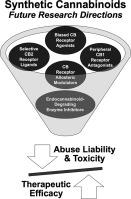Pharmacology Biochemistry and Behavior ( IF 3.3 ) Pub Date : 2020-10-18 , DOI: 10.1016/j.pbb.2020.173059 Dennis J Sholler 1 , Marilyn A Huestis 2 , Benjamin Amendolara 3 , Ryan Vandrey 1 , Ziva D Cooper 4

|
The phytocannabinoid Δ9-tetrahydrocannabinol (THC) was isolated and synthesized in the 1960s. Since then, two synthetic cannabinoids (SCBs) targeting the cannabinoid 1 (CB1R) and 2 (CB2R) receptors were approved for medical use based on clinical safety and efficacy data: dronabinol (synthetic THC) and nabilone (synthetic THC analog). To probe the function of the endocannabinoid system further, hundreds of investigational compounds were developed; in particular, agonists with (1) greater CB1/2R affinity relative to THC and (2) full CB1/2R agonist activity. This pharmacological profile may pose greater risks for misuse and adverse effects relative to THC, and these SCBs proliferated in retail markets as legal alternatives to cannabis (e.g., novel psychoactive substances [NPS], “Spice,” “K2”). These SCBs were largely outlawed in the U.S., but blanket policies that placed all SCB chemicals into restrictive control categories impeded research progress into novel mechanisms for SCB therapeutic development. There is a concerted effort to develop new, therapeutically useful SCBs that target novel pharmacological mechanisms. This review highlights the potential therapeutic efficacy and safety considerations for unique SCBs, including CB1R partial and full agonists, peripherally-restricted CB1R agonists, selective CB2R agonists, selective CB1R antagonists/inverse agonists, CB1R allosteric modulators, endocannabinoid-degrading enzyme inhibitors, and cannabidiol. We propose promising directions for SCB research that may optimize therapeutic efficacy and diminish potential for adverse events, for example, peripherally-restricted CB1R antagonists/inverse agonists and biased CB1/2R agonists. Together, these strategies could lead to the discovery of new, therapeutically useful SCBs with reduced negative public health impact.
中文翻译:

合成大麻素临床使用的治疗潜力和安全性考虑因素
植物大麻素 Δ 9 -四氢大麻酚 (THC) 在 20 世纪 60 年代被分离和合成。此后,基于临床安全性和有效性数据,两种针对大麻素 1 (CB1R) 和 2 (CB2R) 受体的合成大麻素 (SCB) 被批准用于医疗用途:屈大麻酚(合成 THC)和大麻隆(合成 THC 类似物)。为了进一步探索内源性大麻素系统的功能,开发了数百种研究化合物;特别是,激动剂具有(1)相对于 THC 更高的 CB1/2R 亲和力和(2)完整的 CB1/2R 激动剂活性。相对于 THC,这种药理学特征可能会带来更大的误用风险和不良反应,并且这些 SCB 作为大麻的合法替代品(例如新型精神活性物质 [NPS]、“香料”、“K2”)在零售市场上激增。这些 SCB 在美国基本上是非法的,但将所有 SCB 化学品纳入限制性控制类别的一揽子政策阻碍了 SCB 治疗开发新机制的研究进展。人们共同努力开发针对新药理机制的新型、有治疗作用的 SCB。本综述强调了独特 SCB 的潜在治疗功效和安全性考虑因素,包括 CB1R 部分和完全激动剂、外周限制性 CB1R 激动剂、选择性 CB2R 激动剂、选择性 CB1R 拮抗剂/反向激动剂、CB1R 变构调节剂、内源性大麻素降解酶抑制剂和大麻二酚。我们为 SCB 研究提出了有希望的方向,可以优化治疗效果并减少不良事件的可能性,例如外周限制性 CB1R 拮抗剂/反向激动剂和偏向 CB1/2R 激动剂。 总之,这些策略可能会导致发现新的、有治疗作用的 SCB,并减少对公共健康的负面影响。











































 京公网安备 11010802027423号
京公网安备 11010802027423号